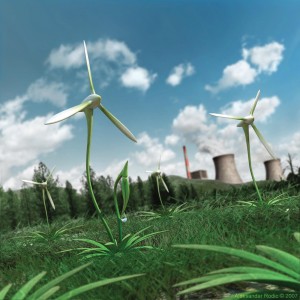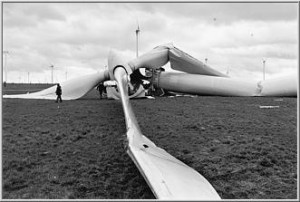 Wind is a natural phenomenon that occurs when molecules move freely in response to differences in air pressure. Likewise, energy can be harnessed for human consumption when blades of a turbine move in response to these innate fluctuations. Wind farming allows for the production of relatively clean energy. The price of this energy, however, is far from free.
Wind is a natural phenomenon that occurs when molecules move freely in response to differences in air pressure. Likewise, energy can be harnessed for human consumption when blades of a turbine move in response to these innate fluctuations. Wind farming allows for the production of relatively clean energy. The price of this energy, however, is far from free.
PROS:
Capturing natural movements from the air through wind farming seems intuitive. Since producing energy by this process requires wind as the sole input, wind farming is a sustainable method of producing power perpetually. This fact sets wind energy apart from nonrenewable fossil fuels like coal, the reserves of which will be depleted in approximately 200 years in the United States given current trends.
Wind farming is “clean”. It requires no inputs other than air movement, which occurs whether or not a turbine is up and running. Aside from minor environmental alterations during their initial construction, turbines do not require extensive environmentally damaging practices like the drilling of oil or mining of coal. Turbines produce no pollutants as byproducts; contrastingly, the burning of fossil fuels can produce billowing clouds of black, CO2-rich smoke in addition to other pollutants. The pumping of CO2 into the atmosphere has caused extensive global climate changes since the onset of the industrial revolution. Essentially, fossil fuels have pushed mother earth into early-onset menopause, her hot flashes spreading across the globe with alarming speed.
Individual turbines provide a large amount of energy for the small land area they occupy. Since the only part of a turbine that contacts the ground is the base and a small generator, they can be strategically placed so that the land can still be used for just about anything—from residential areas to agricultural purposes. Energy sources like coal, oil, and even other renewables including solar panels require much more land area to produce comparable amounts of energy. Even if the small amount of land space were an issue, turbines can be set up in offshore locations that are still directly connected to the energy grid.
In addition to the environmental benefits of wind farming, governments have begun to incentivize the practice for individuals that choose to support this renewable resource and build turbines on their property. Many states, including Indiana and New York, offer loans, grants, and other incentives like tax breaks at the local and federal levels of government. Additionally selling the energy produced by the turbines serves as a steady added income to farmers that sell the energy to power companies.
With all the aforementioned environmental and individual benefits, why did wind power account for less than 1.5% of the world’s total energy production in 2012?
CONS:
In theory, wind is an ideal resource for energy production; however, issues arise when the theory shifts into practice.
 The largest concern with wind farming has to do with the fact that winds are a variable input, and thus do not consistently blow in the same direction or speed. Its unpredictable nature causes people to feel apprehension towards it as a primary source of power; since turbines are connected directly to the energy grid, the generated power must be used shortly after the time of production. Problems arise because individual power needs typically peak in the middle of the day, when winds are weaker and more intermittent. The problem can be avoided in areas with more constant winds, including offshore locations. According to Mark Rodgers, the key correspondent for “Cape Wind”, “offshore wind produces much more energy coincident with electric demand; more power will be produced in the afternoons and less at night, on average”.
The largest concern with wind farming has to do with the fact that winds are a variable input, and thus do not consistently blow in the same direction or speed. Its unpredictable nature causes people to feel apprehension towards it as a primary source of power; since turbines are connected directly to the energy grid, the generated power must be used shortly after the time of production. Problems arise because individual power needs typically peak in the middle of the day, when winds are weaker and more intermittent. The problem can be avoided in areas with more constant winds, including offshore locations. According to Mark Rodgers, the key correspondent for “Cape Wind”, “offshore wind produces much more energy coincident with electric demand; more power will be produced in the afternoons and less at night, on average”.
Turbines are massive metal and fiberglass structures that rotate at high speeds far above the tree line. The image above shows a fallen turbine, the vast hunk of metal resembling a contorted Optimus Prime. While the machines are designed to withstand (and thrive in) strong winds, extreme external forces can result in calamity, especially if the turbines are located in populous regions. With a constantly changing climate, extreme weather conditions (i.e. hurricane Sandy) are at the forefront of many new construction projects. As put by Mark Rodgers, the offshore locale is “designed to withstand a powerful hurricane, and the site in Nantucket Sound offers some protection from open North Atlantic storm waves”. Strategic planning and placement of turbines in low-risk areas can reduce the risk associated with potential turbine tumbles.
Construction of wind farms can prove fairly expensive in the short term, with individual commercial-scale turbines costing somewhere in the neighborhood of $2-4 million dollars, depending on the capacity. The upfront cost presents many people with sticker shock; however, compared to oil wells costing $100 million, the price hurdles seem less extreme. Communities also worry about price changes that are associated with making the switch from a fossil fuel based power grid to a wind-dominated field. Government subsidies have made wind a more realistic option, with energy bills being impacted at most by one to two percent increases in the short-term. Once the infrastructure is built and functioning, however, wind is essentially a free source of power with long-term price stability and predictability for the market.
Initially, turbines were constructed in dense forested areas, which disrupted habitats and posed a threat to bird species. Even in more sparse rural areas, turbines still pose a minimal threat to birds. In the grand scheme of things, however, house cats kill considerably more birds annually than do turbines, so the effect is nearly negligible.
At the end of the day, do the public energy, environmental and economic benefits outweigh the drawbacks?